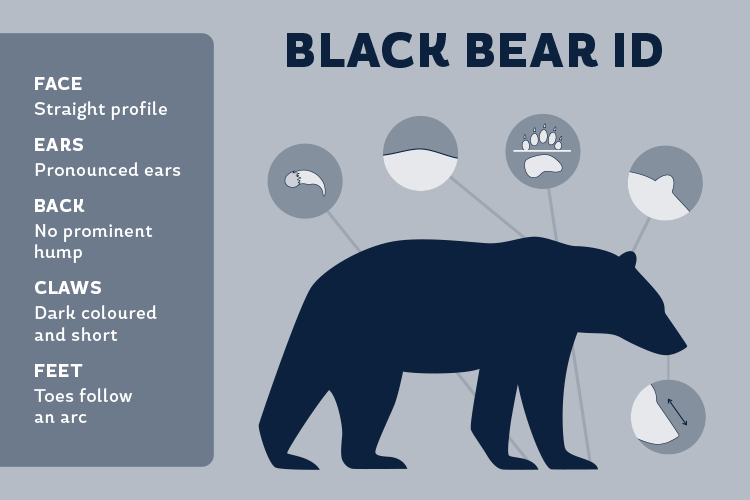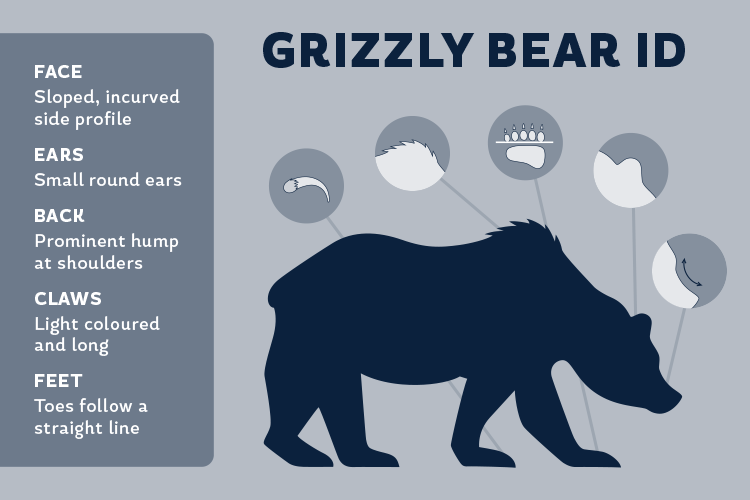Updated August 2023
Whistler is bear country.
These mountains are their home and we are in their territory, especially when we’re exploring the backcountry and high alpine areas. We need to know how we can avoid interactions and possible conflicts, as well as what to do if we find ourselves faced with one.
Whistler is recognized as a Bear Smart Community, but it’s up to all of us to keep it that way. We touched base with the team at AWARE Whistler, a charity organization that works to protect the natural environment in Whistler and the Sea to Sky, who gave us some great information to keep us, and the bears, safe.
Bear Aware Basics
- Keep your distance (at least 100 metres) and give them space (no selfies please)
- A fed bear is a dead bear. Human food habituation is a primary reason bears get destroyed in BC, so keep them wild and safe by storing your food away from prying paws (think garbage, BBQs, picnics, recycling).
- Keep dogs on a leash (much of Whistler’s backcountry does not permit dogs, so make sure you check before you bring Fido along)
Seeing a bear in its natural habitat is incredible and the best way to do so safely is by heading out on a bear viewing tour. Experienced guides know the best spots and a whole load of bear-based knowledge that will just blow you away, like how many berries bears eat in a day (20,000 calories worth), how fast they can run (50 kilometres per hour) and what Whistler’s bear population looks like.
Bear Safety for Hikers and Bikers
- Don’t go it alone: Bring a friend along when you bike, hike and camp in the backcountry. It’s safer for a multitude of reasons, but you tend to make more noise, which alerts bears to your presence.
-
Be alert: Be on the lookout for bear signs such as scat, tree marks and tracks. Also, pay attention if you are around a potential bear food source such as a berry patch or salmon run. Don’t wear headphones – you need to be aware of your surroundings.
-
Let bears know you’re there: Alert bears in the area to your presence by making a lot of noise and trying to keep the wind at your back. If you’re on a bike, slow down for blind turns – a bear could be just around the corner.
- Bring bear spray: Bear spray is an extremely effective, non-lethal bear deterrent. Learning how to use it and always packing it on trips (in an easy-to-reach spot) is a great way to keep you and bears safe (more on that below). In Whistler, you can pick up bear spray at Escape Route, Whistler Hardware and evo Backcountry, to name a few.
What to Do if You See a Bear
The below tips have been taken from the Coast to Cascades Grizzly Bear Initiative website and given a Whistler-specific tweak when relevant.
-
Stop, speak in a calm voice and back away slowly. Check the area for bear cubs and other bears as you do. Never go near a bear cub, as it may provoke the mother bear to attack.
-
DO NOT RUN as it could trigger the bear’s natural instinct to chase.
- Raise your arms above your head to look as big as possible.
-
Recognize the signs of a bear attack. A bear that is growling, popping its jaw, or has its ears laid back is warning you that you’re too close.
-
Bears will often bluff charge, stopping short of actual contact. As hard as it sounds, don’t panic; running, waving your arms, or attacking the bear will only provoke it.
-
If you are attacked by a defensive bear (defending food, cubs, or making lots of noise prior to an attack) drop to the ground face down and try to protect your stomach and vital organs. You have invaded the bear’s space; it’ll threaten you, knock you down and leave.
-
In the rare case you are attacked by a predatory bear, it’ll approach quietly, low to the ground with its ears back. In this case, fight back HARD. Use any deterrent or weapon you have to stop the bear.
What is a Bear Attractant?
We like food, bears like food, we can smell things, bears can smell way more things (their sense of smell is approximately 2,000 times greater than ours).
When you’re hiking, biking and camping in the backcountry make sure you don’t leave a scrap of food anywhere on the trail. That includes the apple core you might think is okay to return to Mother Nature. Leaving these kinds of food on the trail means bears associate humans with food, not to mention they get a taste for things that they wouldn’t usually have access to.
If you’re camping in a location that has no animal-proof disposal facilities (like a bear bin) then you need to hang your food and garbage out of reach and away from your tent in a bear bag. Make sure to store all the items that have had food on them like the stove, utensils etc.
How to Use Bear Spray
Bear spray has been proven to be more effective than a firearm at stopping a charging bear, but it’s no use if it’s at the bottom of your backpack, so make sure it’s somewhere easy to reach. The cans deploy a 25-foot-long cloud of strong pepper spray, which temporarily irritates the bear’s eyes and lungs (you can use it on other animals too, like cougars).
It will also irritate yours, so do not apply bear spray as you do bug spray, don’t leave it in a hot car (it can explode), make sure you read the instructions and take off any zip ties before you head out.
Ideally, everyone in your group should be carrying their own bear spray, but if not, make sure you think about the placement of the person who is carrying it and ensure they know how to use it. The cans do have expiration dates, so check yours before you head out.
Know Your Bears
There are two types of bear species in Whistler, black bears, which are the more predominant kind, and grizzly bears, who are a rarer sighting. Colour and size are not the best indicators to tell them apart. Here’s how you tell the difference:
Black Bears
- No shoulder hump
- Tall, prominent ears
- Front claws are short and dark
- Long, straight snout
- Paw print leaves a curved line made by the front toes
- Colour varies from black to brown

Grizzly Bears
- Prominent shoulder hump (not on younger grizzlies as they take time to develop)
- Small, rounded ears
- Front claws are long and light
- Dished snout and face
- Paw print leaves a straight line made by the front toes
- Colour varies from black to brown

Grizzly bears are more averse to human disturbance, but collar data does show that they move through some of our alpine trail areas, especially on the west side of Whistler Valley, where the Sproatt Rainbow Alpine Network is located. The Resort Municipality of Whistler does issue closures if wildlife conflicts become a concern, so please check before you go if there are any trail advisories.
What If a Bear Is Blocking the Trail?
You’re on the trail, chatting away, turn a corner and there’s a bear right there. What do you do?
Black Bear
“If it’s a black bear, you can try to move it by standing tall and using a loud voice to tell the bear what you want it to do – ‘Hey Bear! Get out of here!’ Make sure your bear spray is handy and ready to go though,” explains Natasha Way, project coordinator at AWARE Whistler. “If that doesn’t work, as sometimes bears are very content eating berries especially in late summer and fall, then go around it, giving it as wide a berth as possible – you may need to go off-trail for a little bit.”
Grizzly Bear
“If it’s a grizzly bear, walk slowly, backwards the way you came. DO NOT try to move the bear,” says Way. “You might need to turn around or wait it out until it is safe to continue on the trail – make sure your bear spray is ready and warn any other hikers on the trail. In all cases, stay together with your group as you will seem larger and more intimidating that way.”
INSIDER TIP: Another incredible resource for information on being bear aware is The Get Bear Smart Society, a charity organization whose goal is to minimize the number of bears killed as a result of human-caused problems.
Know the Alpine Etiquette
If you’re heading into Whistler’s backcountry and high alpine areas you likely have a love for Mother Nature. These areas are particularly sensitive because the conditions are harsh and disturbances can have a ripple effect. Invasive species are a huge threat to alpine ecosystems, so make sure you brush off your boots and tires before switching between alpine and valley walking / riding in order to clear seeds and avoid giving them a free ride.
The below video goes over some of the key tips on how you can help to preserve these incredible natural resources.
Hiking and biking in Whistler’s backcountry and high alpine areas is a privilege. Mother Nature is incredible, but she is fickle, so make sure you’re prepared with the right gear, tell people where you’re heading, when you’re coming back and that you adventure smart.
See you on the trails!
Spring offers great value with savings of up to 25% on lodging. Stretch your stay into midweek for even more savings and a quieter village. For every third night you book between March 1 - April 30, 2025, receive a free $75 CAD Whistler Après Voucher.
For summer, book ahead and save up to 30% on lodging. Plus, you'll receive a free $150 CAD Activity Voucher on stays of 3 or more nights.
Insider Tip: BC or Washington resident? Sign up for Whistler Rewards to access additional savings and exclusive perks.


